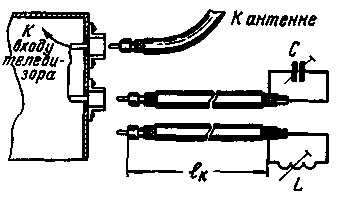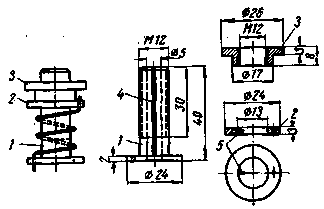Tunable trap filters. Encyclopedia of radio electronics and electrical engineering

Encyclopedia of radio electronics and electrical engineering / Knots of amateur radio equipment. Filters and matching devices
 Comments on the article
Comments on the article
To reduce the effect of interference to television reception from the harmonics of radio stations, idle trap filters are used in the form of open quarter-wave ("Radio", 1961, No. 7, p. 20) or short-circuited half-wave ("Radio", 1961, No. 4, p. 59) segments of coaxial cables. A significant disadvantage of such trap filters is that tuning them to the noise frequency is difficult, since it is done by changing the geometric length of the segment. In addition, the possibility of tuning filters to a different frequency is practically excluded.
These shortcomings can be eliminated by including a variable capacitance or variable inductance at the end of the cable segment.
Almost all types of coaxial cables can be used to suppress harmonic interference in the frequency ranges of 1-12 television channels. When using segments of coaxial cables with polyethylene filler (e = 2,2-2,8) and wave impedance r = 75 Ohm for tunable filters (RK-1, RK-3, RK-4, RK-8, RK-20, RK-49) the lengths of these segments, as well as the values of the minimum and maximum capacitances of the trimmer capacitor (Cmin and Cmax) and the inductance of the trimmer coil (Lmin and Lmax) are given in Table. 1.
| Channels | Filters tunable by capacitance | Filters tunable by inductance |
| Cut length, cm | Cmin, pF | Cmax, pF | Cut length, cm | Lmin, mcgn | Lmax, μH |
| 1 | 64 | 15 | 32 | 130 | 0,22 | 0,70 |
| 2 | 55 | 13 | 25 | 110 | 0,17 | 0,56 |
| 3 | 43 | 10 | 18 | 86 | 0,15 | 0,36 |
| 4 | 39 | 9 | 16 | 78 | 0,13 | 0,32 |
| 5 | 36 | 8 | 14 | 72 | 0,12 | 0,26 |
| 6 | 20 | 4 8 | 6 3 | 49 | 0,067 | 0,12 |
| 7 | 19,5 | 4 6 | 6 0 | 39 | 0,062 | 0,115 |
| 8 | 19 | 4 4 | 5 7 | 37 | 0,060 | 0,11 |
| 9 | 18 | 4 2 | 5 5 | 36 | 0,057 | 0,105 |
| 10 | 17 | 4 0 | 5 3 | 34 | 0,055 | 0,10 |
| 11 | 16.5 | 3 9 | 5 1 | 33 | 0,053 | 0,097 |
| 12 | 16 | 3 8 | 4 9 | 32 | 0,051 | 0,094 |
In the case of the use of coaxial cables with polyethylene filler (e=2,2-2,3), but the characteristic impedance r' is not equal to 75 Ohm (RK-2, RK-6, RK-19, RK-48, RKV), the required cable lengths for 1-12 television channels are equal to those given in the same table, and the minimum and maximum capacitance or inductance values must be calculated using the following formulas:

Tunable notch filters must be connected in parallel with the television receiver antenna. Structurally, the filter is made in the form of a cable segment, to one end of which a television antenna plug is attached, and a trimmer capacitor or coil with a variable inductance is connected to the other (Fig. 1).

Ris.1
The design of the variable inductance coil is shown in fig. 2. The frame of the coil is made of organic glass and consists of two separate parts - fixed 1 and movable 2. On the fixed half there is a thread for screwing the nut 3. The change in the coil inductance occurs due to a change in the winding pitch when unscrewing or screwing the nut.

Ris.2
To prevent the rotation of the movable half of the frame when the nut is rotated, a groove 4 is made on the fixed half, in which the pin 5 goes, inserted into the movable half. Since the change in the length of the coil when unscrewing the nut occurs only due to the elastic state of the turns of the coil, it is advisable to use a bronze wire with a diameter of 1 mm to wind the coil.
The winding data of the coils for various television channels are given in Table. 2.
| Channels | 1 | 2 | 3 | 4-5 | 6-12 |
| Number of turns | 7 | 6 | 4,5 | 4 | 2,5 |
To turn on a piece of cable parallel to the antenna on TVs that have only one antenna socket, you need to install the second one and turn it on in parallel with the main one. On TVs that have two antenna sockets, one of them can be used to turn on a piece of cable. To do this, from the socket that is not used to turn on the antenna, it is necessary to unsolder the parts and connect this socket in parallel with the one used. In the absence of interference, the filter must be disconnected from the TV, as it attenuates the useful signal.
When it is necessary to attenuate the harmonics emitted by the HF transmitter, a tunable notch filter is soldered directly to the antenna feeder (see "Radio", 1961, No. 7). Since the fundamental frequency of the transmitter is usually much lower than the resonant frequency of the filter, it practically does not consume the useful power of the transmitter and there is no need to turn it off. The cable segments of the filters connected to the transmitters must have a high operating voltage, since due to the voltage resonance that occurs when the filter is tuned, breakdown of the cable insulation is possible.
Author: N. Semenyuta; Publication: N. Bolshakov, rf.atnn.ru
 See other articles Section Knots of amateur radio equipment. Filters and matching devices.
See other articles Section Knots of amateur radio equipment. Filters and matching devices.
 Read and write useful comments on this article.
Read and write useful comments on this article.
<< Back
 Latest news of science and technology, new electronics:
Latest news of science and technology, new electronics:
Air trap for insects
01.05.2024
Agriculture is one of the key sectors of the economy, and pest control is an integral part of this process. A team of scientists from the Indian Council of Agricultural Research-Central Potato Research Institute (ICAR-CPRI), Shimla, has come up with an innovative solution to this problem - a wind-powered insect air trap. This device addresses the shortcomings of traditional pest control methods by providing real-time insect population data. The trap is powered entirely by wind energy, making it an environmentally friendly solution that requires no power. Its unique design allows monitoring of both harmful and beneficial insects, providing a complete overview of the population in any agricultural area. “By assessing target pests at the right time, we can take necessary measures to control both pests and diseases,” says Kapil ... >>
The threat of space debris to the Earth's magnetic field
01.05.2024
More and more often we hear about an increase in the amount of space debris surrounding our planet. However, it is not only active satellites and spacecraft that contribute to this problem, but also debris from old missions. The growing number of satellites launched by companies like SpaceX creates not only opportunities for the development of the Internet, but also serious threats to space security. Experts are now turning their attention to the potential implications for the Earth's magnetic field. Dr. Jonathan McDowell of the Harvard-Smithsonian Center for Astrophysics emphasizes that companies are rapidly deploying satellite constellations, and the number of satellites could grow to 100 in the next decade. The rapid development of these cosmic armadas of satellites can lead to contamination of the Earth's plasma environment with dangerous debris and a threat to the stability of the magnetosphere. Metal debris from used rockets can disrupt the ionosphere and magnetosphere. Both of these systems play a key role in protecting the atmosphere and maintaining ... >>
Solidification of bulk substances
30.04.2024
There are quite a few mysteries in the world of science, and one of them is the strange behavior of bulk materials. They may behave like a solid but suddenly turn into a flowing liquid. This phenomenon has attracted the attention of many researchers, and we may finally be getting closer to solving this mystery. Imagine sand in an hourglass. It usually flows freely, but in some cases its particles begin to get stuck, turning from a liquid to a solid. This transition has important implications for many areas, from drug production to construction. Researchers from the USA have attempted to describe this phenomenon and come closer to understanding it. In the study, the scientists conducted simulations in the laboratory using data from bags of polystyrene beads. They found that the vibrations within these sets had specific frequencies, meaning that only certain types of vibrations could travel through the material. Received ... >>
 Random news from the Archive Random news from the Archive Toshiba TC358870XBG - 4K HDMI/MIPI Dual-DSI Converter
13.05.2014
Toshiba Electronics Europe (TEE) announced the launch of the TC358870XBG, the industry's first HDMI to MIPI dual-DSI converter chipset with 4K resolution and video format conversion.
The chip supports 4K Ultra HD resolution (3840 x 2160 pixels) at a refresh rate of 30 fps using a dual-DSI interface. They also support WQXGA (2560 x 1600) resolution at 60 fps and Full HD resolution at 120 fps. The manufacturer notes the minimum conversion delay, which improves the performance of real-time gaming applications and virtual reality products that use high-resolution displays.
In addition, TC358870XBG supports conversion of HDMI input audio stream to I2S, TDM or SLIMbus (Serial Low-power Inter-chip Media Bus), which expands the scope of its application.
For the external design of the TC358870XBG, an FBGA80 package with dimensions of 7 x 7 mm with a lead pitch of 0,65 mm was selected. Delivery of trial samples of TC358870XBG began at the end of April, and the start of mass production is scheduled for September.
Recall that in March, the Toshiba TC358840XBG chip was released - the industry's first 4K video stream converter from HDMI to MIPI CSI-2 without compression and loss.
|
 Other interesting news:
Other interesting news:
▪ Headphones will monitor brain health and recommend music for your mood
▪ Found the coldest place in the solar system
▪ electric car
▪ Inkjet printers print finished electronic devices
▪ IO Data mobile battery charges two devices at the same time
 News feed of science and technology, new electronics
News feed of science and technology, new electronics
 Interesting materials of the Free Technical Library:
Interesting materials of the Free Technical Library:
▪ site section Welding equipment. Article selection
▪ article Business planning. Crib
▪ article Do ants always live in colonies? Detailed answer
▪ article Distribution of soap and disinfectants
▪ article Microwave field detector. Encyclopedia of radio electronics and electrical engineering
▪ article Bring the boxes closer with a whiff. Focus secret
 Leave your comment on this article:
Leave your comment on this article:
 All languages of this page
All languages of this page
Home page | Library | Articles | Website map | Site Reviews

www.diagram.com.ua
2000-2024







 Arabic
Arabic Bengali
Bengali Chinese
Chinese English
English French
French German
German Hebrew
Hebrew Hindi
Hindi Italian
Italian Japanese
Japanese Korean
Korean Malay
Malay Polish
Polish Portuguese
Portuguese Spanish
Spanish Turkish
Turkish Ukrainian
Ukrainian Vietnamese
Vietnamese



 Leave your comment on this article:
Leave your comment on this article: